Cytospora (Diaporthales) in China
- PMID: 34456370
- PMCID: PMC8375343
- DOI: 10.3767/persoonia.2020.45.01
Cytospora (Diaporthales) in China
Abstract
Members of the genus Cytospora are often reported as endophytes, saprobes or phytopathogens, primarily causing canker diseases of woody host plants. They occur on a wide range of hosts and have a worldwide distribution. Although several species have in the past been reported from China, the vast majority are not known from culture or DNA phylogeny. The primary aim of the present study was thus to clarify the taxonomy and phylogeny of a large collection of Cytospora species associated with diverse hosts in China. Cytospora spp. were collected in northeast, northwest, north and southwest China, indicating that the cold and dry environments favour these fungi. In this paper, we provide an assessment of 52 Cytospora spp. in China, focussing on 40 species represented by 88 isolates from 28 host genera. Based on a combination of morphology and a six-locus phylogeny (ITS, LSU, act1, rpb2, tef1-α and tub2), 13 new species and one new combination are introduced. The majority of the species investigated here appear to be host-specific, although further collections and pathogenicity studies will be required to confirm this conclusion.
Keywords: Valsa; canker disease; new taxa; plant pathogen; systematics; taxonomy.
© 2019–2020 Naturalis Biodiversity Center & Westerdijk Fungal Biodiversity Institute.
Figures


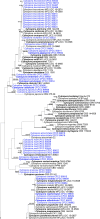

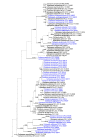










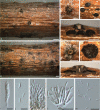




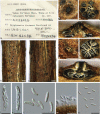




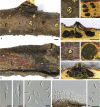






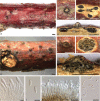










References
-
- Adams GC, Roux J, Wingfield MJ, et al. . 2005. Phylogenetic relationships and morphology of Cytospora species and related teleomorphs (Ascomycota, Diaporthales, Valsaceae) from Eucalyptus. Studies in Mycology 52: 1–144.
-
- Adams GC, Roux J, Wingfield MJ. 2006. Cytospora species (Ascomycota, Diaporthales, Valsaceae), introduced and native pathogens of trees in South Africa. Australasian Plant Pathology 35: 521–548.
-
- Adams GC, Surve-Iyer RS, Iezzoni AF. 2002. Ribosomal DNA sequence divergence and group I introns within the Leucostoma species L. cinctum, L. persoonii, and L. parapersoonii sp. nov., ascomycetes that cause Cytospora canker of fruit trees. Mycologia 94: 947–967. - PubMed
-
- Ariyawansa HA, Hyde KD, Jayasiri SC, et al. . 2015. Fungal diversity notes 111–252 – taxonomic and phylogenetic contributions to fungal taxa. Fungal Diversity 75: 27–274.
-
- Barr ME. 1978. The Diaporthales in North America with emphasis on Gnomonia and its segregates. Mycologia Memoir 7: 1–232.
LinkOut - more resources
Full Text Sources
Miscellaneous
